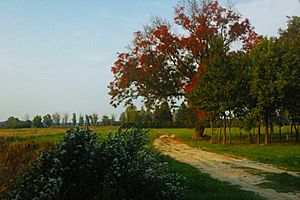Meadow facts for kids


A meadow is a special kind of open field. It is mostly covered by grass and other non-woody plants, like wildflowers. Meadows are not usually covered by trees or large bushes. They can be natural places, or they can be created and managed by people.
Meadows are often used for farming. Farmers might cut the plants to make hay, which is dried grass used to feed livestock like cattle, sheep, or goats. Animals can also graze directly on the meadow, eating the fresh plants.
Contents
What is a Meadow?
A meadow is an area of land where grasses and other small plants grow freely. Unlike forests, meadows do not have many trees. They are often flat or gently rolling. Meadows are important parts of many landscapes around the world. They can be found in valleys, on hillsides, or even in cities.
Natural Meadows
Some meadows are completely natural. They have formed over thousands of years without much help from humans. These natural meadows are often found in places with specific climates, like:
- Prairies: Large grasslands in North America.
- Steppes: Similar dry grasslands found in Europe and Asia.
- Savannas: Grasslands with scattered trees, common in Africa.
- Tundra: Cold, treeless plains found in Arctic regions.
These natural meadows are home to many unique plants and animals that have adapted to living in open, grassy areas.
Human-Made Meadows
Many meadows we see today have been created or managed by people. These include:
- Hay meadows: These are fields where farmers grow grass and other plants specifically to cut and dry for hay. Hay is important food for farm animals, especially in winter.
- Pastures: These meadows are used for animals like cows, sheep, or horses to graze directly. The animals eat the grass, which helps keep the meadow healthy.
- Urban meadows: Some cities create meadows in parks or along roadsides. These are often planted with wildflowers to make the area look nice and help local wildlife.
Why Meadows are Important
Meadows are much more than just fields of grass. They play a very important role in nature and for people.
Home for Wildlife
Meadows are like busy neighborhoods for many creatures. They provide food and shelter for:
- Insects: Bees, butterflies, and other insects love the wildflowers in meadows. They collect nectar and pollen, which helps plants make seeds.
- Birds: Many birds build nests in the tall grasses and hunt for insects or seeds.
- Small Mammals: Animals like rabbits, mice, and voles live in meadows. They find food and hide from predators.
- Larger Animals: Deer and other larger animals might visit meadows to graze.
Helping the Environment
Meadows also help the environment in several ways:
- Clean Air: Plants in meadows take in carbon dioxide and release oxygen, helping to clean the air we breathe.
- Healthy Soil: The roots of meadow plants hold the soil together. This stops soil from being washed away by rain or blown away by wind.
- Water Filtration: Meadows can help filter rainwater as it soaks into the ground, making the water cleaner.
Benefits for People
People also benefit from meadows:
- Food for Animals: As mentioned, meadows provide hay and grazing land for farm animals, which helps produce food like meat and milk.
- Beauty and Recreation: Meadows are beautiful places to visit. People enjoy walking, picnicking, or simply enjoying nature in meadows.
- Pollination: The bees and other insects that live in meadows help pollinate crops in nearby farms, which is vital for growing fruits and vegetables.
Protecting Meadows
Many meadows around the world are disappearing because of development or changes in farming. It is important to protect these valuable habitats. People can help by:
- Supporting conservation efforts that protect natural grasslands.
- Creating small meadows in gardens or public spaces.
- Learning more about the plants and animals that live in meadows.
By understanding how important meadows are, we can work together to keep them healthy for future generations.
Related pages
Images for kids
-
Urban Meadow at Botaniska Trädgården, Uppsala, Sweden
-
An urban meadow at Tifft Nature Preserve in Buffalo, New York
-
An uncut hay meadow.
-
An orchard meadow.
-
The perpetual alpine meadows in Uttarakhand, India (western Himalayas).
-
The Coastal meadows at the Bay of Biscay near Tapia de Casariego, Spain
-
A desert meadow near Walla Walla, Washington USA.
-
Perpetual meadows in Oregon, USA.
-
Natural meadows and grasslands at Lake Baikal, Russia.
-
Flood meadow near Hohenau an der March, Austria
-
Meadows in Shangarh, Himachal Pradesh, India
See also
 In Spanish: Prado para niños
In Spanish: Prado para niños






















